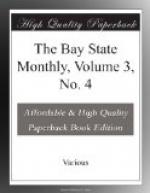The impression left upon the mind of the traveller who has seen Hingham only from the railroad train would be one of backyards, a mill-pond, and woods; but to him who approaches it towards the close of a pleasant June day by steamboat, when the tide is in, there is spread out a lovely view. As the boat comes near the landing-place, islands and green hills, beautiful trees and fields, form a complete circle around him. The picture is one he will not forget. This pleasant impression will grow stronger if he drives by almost any of the streets leading from the harbor, for about five miles, to the southern limit of the town. Should he take the main street he will be charmed by the wealth of stately elms and other shade-trees, which in many places form a complete arch over his head, and by the neat dwellings, for the most part of modest pretensions, some old and some new, almost every one with well-kept grounds all betokening thrift and suggesting a well-to-do community. Nor need he confine himself to the main street. Several of the thickly settled villages spread out into equally attractive side streets. Here and there a church, a school-house, or a public building adds to the general tidy look of the place. Numerous pleasant wood roads, with a few fresh water ponds and streams, make up a variety of scenery which is certainly equal to any New England town.
[Illustration: THE “OLD MEETING HOUSE.”]
“Do you have any poor here?” was once asked by a visitor. “I see no evidence of anything but plenty, and yet you do not seem to have any specially leading industries. Whence comes this prosperity?” Whence, indeed? The history of the settlement and growth of Hingham differs little from many another town in eastern Massachusetts. Founded by the Puritans, it is the same story of hardship, patient, persistent toil, prudent economy, encouragement of education and morality, which has been told over and over again, and which has demonstrated the sure foundation upon which true civilization rests.
Hingham lies on the south shore of Massachusetts Bay, on the line of the Old Colony Railroad, 17 miles from Boston by railroad and about 13 by water. Its area is a little less than 13,000 square acres, and its population in 1880 was 4,485. Its valuation in 1884 was $3,245,661, and the number of dwelling-houses was 1,044. Its original limits included the present town of Cohasset, which was set off and incorporated April 26, 1770. Until March 26, 1793, Hingham was a part of Suffolk county, when it was annexed to the County of Norfolk, and June 20, 1793, it again became a part of the County of Suffolk. June 18, 1803, it was annexed to the County of Plymouth, of which it has since formed a part.
[Illustration: THE SOLDIERS’ AND SAILORS’ MONUMENT.]




